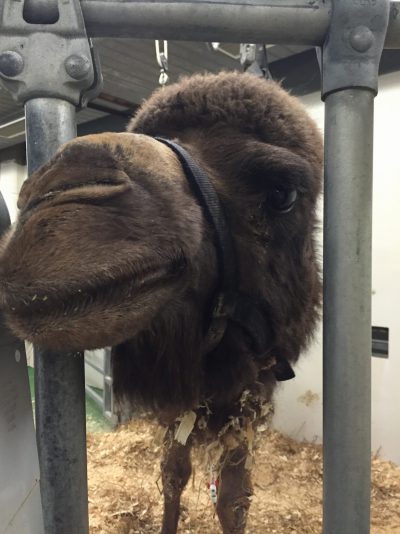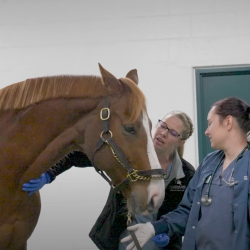History and Diagnosis

A five-year-old Dromedary female camel named Mirage was presented to Michigan State University (MSU) Veterinary Medical Center (VMC) on emergency for further evaluation and treatment due to profuse diarrhea, recumbency, and an inability to stand. When she arrived, Mirage was in lateral recumbency and minimally responsive and judged to be approximately 8% dehydrated. Initial hematological evaluation revealed hypothermia, severe azotemia, and severe hyperkalemia.
Treatment and Outcome
Mirage presented to Drs. Vanessa Cook and Jamie Kopper at the Large Animal Emergency Service. Upon arrival, she was recumbent and minimally responsive in the trailer and had to be moved into the hospital while simultaneously instituting emergency diagnostic and stabilization measures. An intravenous jugular catheter was placed and emergency stabilization measures were taken due to Mirage’s severe dehydration and severe hyperkalemia. Mirage was administered a 2 liter bolus of hypertonic saline for rapid intravascular volume expansion followed by a 20 liter bolus of polyionic rehydration intravenous fluids. Additionally, due to concerns that her hyperkalemia could result in sudden cardiac arrest, Mirage was administered a 500 ml bolus of 50% dextrose to reduce her extracellular potassium. Several times during initial fluid resuscitation, Mirage became non-responsive with dilated and unresponsive pupils. However, after volume resuscitation, Mirage became increasingly bright and alert and was then able and willing to stand unassisted. Repeat venous blood gas analysis confirmed normalization of both serum creatinine and potassium values over the next 24 hours.
Once Mirage was stabilized, Drs. Cook and Kopper had to determine the underlying cause of her diarrhea, which likely resulted in her severe dehydration and renal injury. Routine fecal flotation analysis revealed large numbers of both Trichuris spp. eggs and Trichostrongylus type eggs. Luckily, Mirage was negative for both Johnes disease and Salmonella spp.
A strategic deworming program was instituted to target the known parasite population with re-evaluation of her fecal samples to confirm reduction in her parasite burden and to gain more information about possible anti-helminthic resistance on the farm. Mirage remained hospitalized for several days while she regained strength and the ability to eat and drink on her own.
Comments
Parasitism is not considered to be life threatening by many owners or, as in Mirage’s case, her owners had been deworming her (without a fecal-parasite evaluation plan in place) and were under the impression that they were taking care of any potential parasite problem with a standard rotational deworming program. Due to the high levels of anti-helminthic resistance found in the parasite populations, we are recommending that all large animal species participate in a strategic deworming program. These programs involve assessing them for evidence of parasitism by fecal flotation, administering an appropriate medication based on their fecal results, and then reassessing a fecal sample to ensure that there was adequate reduction in the fecal egg count, indicating that resistance to the chosen medication was not present.
MSU VMC’s Large Animal Clinic provides around-the-clock specialized care to all types of large animals, including horses, goats, pigs, cows, and camelids, 365 days a year, 24 hours a day.



